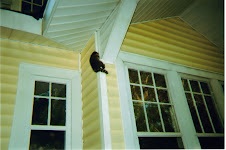When looking into keeping backyard chickens in an urban setting, I was looking for calm, easy going, friendly, non-skittish and good winter layers/good layers all around and the main criteria I wanted was an ALL BROWN EGG FLOCK. So the hunt was really intense, reading everything I could on the different birds, asking some fellow Master Gardener Interns I was in class with that have flocks and just really burning up the internet search.
I would like to introduce you to some of the "girls" I will be getting. Here is a Barred Plymouth Rock or more commonly called just Barred Rock. These are layers of large brown eggs, good winter layers, large full bodies and very calm & docile hens, often topping out at maturity often at around 7+ lbs. and I present it here below.


Now here is another choice I have made. This is the Black Australorp. They mature early and often laying between 5-6 months. They top out as well around 7lbs., lay large brown eggs and in unlighted conditions in winter have even been known in barnyard testing to lay 364 eggs in 365 days. Bred in Australia in the early 1900's it was introduced in the USA around 1920. Bred for large, prolific egg producers without sacrificing the meat utility as well, these lovely black ladies have a green to purple-black sheen in sunlight and they show well at most county fairs.

Third on Garden Daddy's list for this urban farm is the Silver Laced Wyandotte. I think this hen is one of the prettiest around. It has been one of the best American bred varieties that has been around for some time now. Good sized eggs from light to rich brown, these as well are great winter layers due to their small, rose comb that is not affected by cold weather. In case you are not aware of it, the larger a hen's comb is, the less of a winter layer she is and any hen that has a colored ear is a brown egg layer. This variety is very much a show or exhibition bird and maybe this Garden Daddy will have a fall fair entry if these look half way decent! Look below for this wonderful bird.

Fourth on this urban farm list of chickens is the Buff Orphington. Breed history says to "take out your gold pocket watch and that is the true color of the Buff Orphington". Introduced here from England in the late 1800's, these are large, stately birds with a very quiet disposition. Again a brown egg machine through winter as well, these "Golden Girls", with their heavy, full plumage are a barnyard favorite and "shell" out eggs for years and definitely are worth their weight in "gold"! Here are these beauties below.

Fifth and next to last on the list of what this Garden Daddy is adding to this urban farm garden is the Delaware. This mostly white bird with barring on the tail and in the hackle, will be another lovely addition to this flock. This breed was founded in the state of Delaware of course, from crossing a Barred Rock with a New Hampshire cross. A heavy breed of bird which lays a nice large to JUMBO brown egg, the hens will reach about 6lbs. and are considered a nice "stewing" bird when their time in the nest is done, about 4-years for most all chickens. Enjoy the pic below and think of those double yolk eggs going into your next cake mix!
Last on this Garden Daddy's list is the one I have always wanted for most of my adult life since thinking about raising chickens. Welcome to the world of the Ameraucanas. This great bird lays "tinted" or pastel eggs, due to the crosses made with the jungle type of foul from the Auracana Indians in South America. Often mistakenly called "Easter Eggers" and different from the Auracana chickens that have no tail due to not having the last few vertebrae in the spine, these lighter weight wonders are mostly just for fun and possible exhibition later on as well. Not prolific but efficient layers, these birds have "beards" or "muffs" around/under their neck and often ear tuffs that are a throw back to the jungle birds. These are calm, friendly and curious but can be picky about their nest box. I am looking forward to this addition to the flock as you can see below! This is a "buff" colored one but the range of color is amazing and often very vivid as well.


(For the record, NONE of these photos are from this urban farm, but from public sites or hatcheries for public use. I make no claim to these photos.)
Garden Daddy hopes you find this both informative and as much fun as I do when I actually get my little birds. I am working on the brooder today and should have it finished in the morning. I will post something about it then. For now I leave you with thoughts of lots of egg salad sandwiches, bright yolks of fun (deep, rich ones I hope) and thoughts of some good fertilizer for this urban farm garden site(s). I give you over to our ongoing daily gardening affirmation: "GARDENING: ONE YARD AT A TIME!"







































